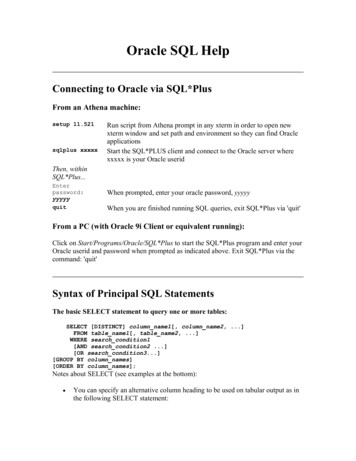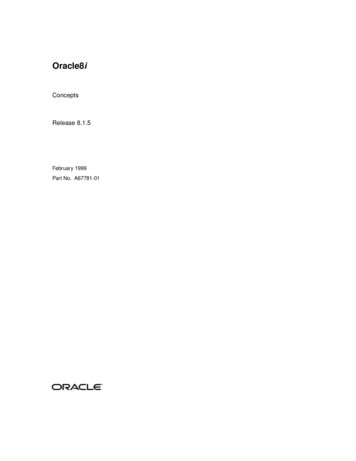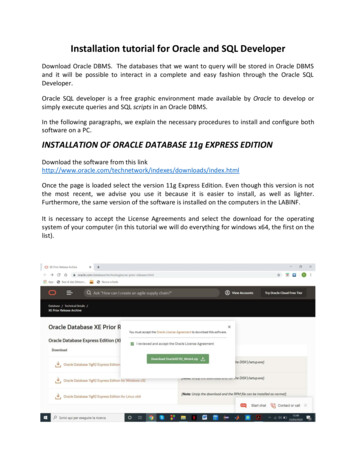
Transcription
Oracle SQL HelpConnecting to Oracle via SQL*PlusFrom an Athena machine:setup 11.521sqlplus xxxxxRun script from Athena prompt in any xterm in order to open newxterm window and set path and environment so they can find OracleapplicationsStart the SQL*PLUS client and connect to the Oracle server wherexxxxx is your Oracle useridThen, withinSQL*Plus.Enterpassword:yyyyyquitWhen prompted, enter your oracle password, yyyyyWhen you are finished running SQL queries, exit SQL*Plus via 'quit'From a PC (with Oracle 9i Client or equivalent running):Click on Start/Programs/Oracle/SQL*Plus to start the SQL*Plus program and enter yourOracle userid and password when prompted as indicated above. Exit SQL*Plus via thecommand: 'quit'Syntax of Principal SQL StatementsThe basic SELECT statement to query one or more tables:SELECT [DISTINCT] column name1[, column name2, .]FROM table name1[, table name2, .]WHERE search condition1[AND search condition2 .][OR search condition3.][GROUP BY column names][ORDER BY column names];Notes about SELECT (see examples at the bottom): You can specify an alternative column heading to be used on tabular output as inthe following SELECT statement:
SELECT medianhinc income, whitepop blackpop peopleFROM census Comparisons for search condition: equality inequality! inequality greater than greater than or equal to less than less than or equal toIN (a, b, c, .)one of a, b, c, etc.BETWEEN a AND b greater than or equal to a and less than or equal to bCreating a temporary table:CREATE TABLE tempname ASSELECT [.same as above.]Creating a table from scratch:CREATE TABLE table name(columname1 datatype1[, columname2 datatype2, .]);The primary data types are: number, date, and varchar2(n) where 'n' is an integerNested queries:SELECT [.same as above.]FROM table nameWHERE column name IN(SELECT .);Multiple table joins (simple example):SELECT e.name, d.floorFROM employee e, department dWHERE e.dname d.dname and e.name 'joe';Update operations (change values in existing rows):
UPDATE table nameSET column name1 expression1 [, .][WHERE search condition];Views (like a table but the SQL command, and not the data, is saved):CREATE VIEW view name [(column name1, column name2, .)]AS SELECT column namesFROM table nameWHERE search conditionSelecting a portion of a character string:SELECT SUBSTR(lastname,1,10) lastname10FROM table name;A Few Examples from the Sample PARCELS DatabaseNote that comments that will be ignored by SQL*Plus can be introduced at any point on aline by using two dashes (--). Everything after the two dashes on the line will be ignored.-- 1. The simplest query on the TAX tableSELECT * FROM tax;-- 2. A query with an expression and a column aliasSELECT parcelid, (landval bldval) tot val, taxFROM tax;-- 3. A simple query that groups over a whole tableSELECT COUNT(*), MIN(tax), MAX(tax), AVG(tax)FROM tax;-- 4. This example uses a literal string in the SELECT listSELECT parcelid, 'Total prop value is', (landval bldval), taxFROM tax;-- 5. The simplest query from the PARCELS tableSELECT * FROM parcels;-- The COLUMN command is not a SQL command but rather a SQL*Plus-- command that tells the program how to format column output.-- This is very useful for producing readable output.-- The first example formats a numeric column to display 3 digits('990').-- The second formats a character column to display 8 characters('A8').-- See the SQL*Plus Reference information on the COLUMN command-- for details on specifying the formats.COLUMN parcelid FORMAT 990COLUMN add2 FORMAT A8
-- 6. The simplest query on the PARCELS tableSELECT * FROM parcels;-- 7. A simple query using the "IS NULL" syntaxSELECT *FROM parcelsWHERE sqft 20000 OR sqft IS NULL;-- 8. Compare the results of the query above with the one below.-- Why are they different?SELECT *FROM parcelsWHERE sqft 20000 OR sqft NULL;-- 9. A query to find values within a certain rangeSELECT *FROM parcelsWHERE sqft 10000 AND sqft 100000;-- 10. Another way of writing the query above using the-- "BETWEEN" keywordSELECT *FROM parcelsWHERE sqft BETWEEN 10000 AND 100000;-- 11.SELECTFROMWHEREA simple join between PARCELS and FIRESp.*, f.estlossparcels p, fires fp.parcelid f.parcelid;-- 12. A slight variationSELECT p.parcelid, p.sqft, p.landuse, f.estlossFROM parcels p, fires fWHERE p.parcelid f.parcelidORDER BY f.estloss;-- 13. ASELECTFROMGROUP BYORDER BYsimple GROUP BY queryzip, COUNT(DISTINCT pid) parcels, AVG(sqft) avg sqftparcelszipzip;-- 14. Show all the firesSELECT f.*FROM fires fORDER BY f.parcelid, f.fdate;-- 15. Show all the fires that have a matching record-- in the ZONING table.SELECT f.*FROM fires f, zoning zWHERE f.parcelid z.parcelidORDER BY f.parcelid, f.fdate;-- 16. This example uses the "NOT IN" syntax
-- with a subquery to find the fires that-- do NOT have a matching record in the-- ZONING table (i.e., the records from query-- 14 that did NOT appear in query 15).SELECT f.*FROM fires fWHERE f.parcelid NOT IN(SELECT z.parcelidFROM zoning z);-- 17. A three-table join to show the owners of parcels-- with firesSELECT p.parcelid, landuse, oname, estlossFROM parcels p, owners o, fires fWHERE p.parcelid f.parcelid andp.onum o.ownernumORDER BY oname;-- 18. Find the properties owned by "GERALD RAPPAPORT"-- that had fires and permits.SELECT distinct o.oname, p.add1, p.add2, p.parcelidFROM owners o, parcels p, fires f, permits eWHERE o.oname 'GERALD RAPPAPORT'AND o.ownernum p.onumAND p.parcelid f.parcelidAND p.pid e.pid and p.wpb e.wpb;Using the SQL*Plus Interface to Oracle's SQLHere are some useful tips and tricks to customize your SQL*Plus environment and tosave and retrieve SQL queries and output tables from UNIX files:SELECT * FROM cat;This SQL query lists most of the tables (and synonyms and views) from which you havepermission to make selections including all those that you have created (but not some thatothers have created and given you permission to use).SQL*Plus stores your most recent SQL statement in a buffer. You place a command inthe buffer either by typing (or cutting-and- pasting) one in at the 'SQL ' prompt orloading one in from a file. The following commands make use of the SQL buffer:GET fileLoads file into the SQL buffer. By default, SQL*Plus assumes that the file name endswith '.sql'. For example, the commandsGET query1.sqlandGET query1load the same file. The file should contain only one SQL statement.SAVE fileSAV fileSaves the statement in the SQL buffer to file. The file extension '.sql' is assumed. Hence,the commands SAVE query2.sql and SAVE query2 will write to the same file.
LISTLLists the contents of the SQL bufferRUNRLists and runs the current command in the SQL buffer/ (forward slash)Runs the current command in the SQL buffer without listing it firstSTART fileSTA file@fileLoads and runs the commands in file. The extension '.sql' is assumed. For example, thecommand START command1.sql and START command1 execute the same file. UnlikeGET, files run with START may contain many SQL statements or SQL*Pluscommands.SPOOL fileSPO fileBegins saving all output from the SQL*Plus session (including what you type) to file.The file extension '.lst' is assumed. Hence, the commands SPOOL log.lst and SPOOLlog would both create a file called 'log.lst'.SPOOL OFFSPO OFFStops writing SQL*Plus output to a spool file opened using the 'SPOOL file' command.SET ECHO ONAfter this command is issued, the START command will display each statement in thecommand file just before it is executed.SET ECHO OFF
After this command is issued, the START command will not display statements in thecommand file as they are executed.SET LINESIZE nSets the number of characters printed on a line to n. For example,SET LINESIZE 150will instruct SQL*Plus to print 150 characters on a line. This command is useful onceyou have increased the width of an xterm window beyond the standard 80 characters tosee more columns. The default setting is 'SET LINESIZE 80'.SET PAGESIZE nSets the number of lines that SQL*Plus displays before repeating the column headings ton. The default setting is 'SET PAGESIZE 14', which is generally too small. 'SET PAGESIZE24' is recommended.SET PAUSE '--Hit return to continue--'SET PAUSE ONUse these two commands to cause SQL*Plus to pause before each page of output. Notethat a pause will also occur before the FIRST page, so that you will need to press thereturn key to see any output.HELPHELP topicAccesses the on-line help system. 'HELP' alone displays an introductory message; 'HELPtopic' provides information about a specific topic. For example, HELP SELECT providesinformation about the SELECT statement.COLUMN column name FORMAT format typeSets the display format of columnname to formattype. Using this command can helpimprove the appearance of your queries. Some examples:COLUMN FTYPE FORMAT A5COLUMN HHINDEX FORMAT 999990COLUMN TENURE FORMAT 9990.0Note that each SQL statement you enter should be terminated with a semicolon (;). If youforget it, you can enter it on a line by itself or use the forward slash (/) to run yourstatement. SQL statements (e.g., SELECT, INSERT, UPDATE, DELETE) may be spread
over any number of lines; just press return when you want to start a new line. Usingmultiple lines for each clause in the statement significantly improves their readability, sothis technique is highly recommended. SQL*Plus commands that are NOT SQLstatements (e.g., SET, SPOOL, HELP, COLUMN) must appear on one line and do NOTrequire semicolons at the end.SQL statements and SQL*Plus commands are NOT case sensitive. Case DOES matter,however, for any text enclosed in either single (') or double (") quotation marks.Creating Unique Temporary TablesDoing the homework exercises requires setting up temporary tables. At least initially, theclass setup for Oracle has everyone using the same Oracle userid for some of the classdatasets. Hence, several people could end up trying to create a table with the same nameat the same time. To avoid this problem, you should pre-append a unique id to the nameof every temporary table that you create. Suppose, for example, the 7th person in theclass list wanted to save all parcels with more than 10,000 square feet into a temporarytable called BIGPARCELS. Then this person would append 't7' to the front of anytemporary table name. For example:CREATE TABLE t7bigparcels asSELECT *FROM parcelsWHERE sqft 10000;When done with the table, please 'drop' it via:DROP TABLE t7bigparcels;so that the database is not cluttered with lots of old temporary tables.Oracle ReferencesComplete Oracle 8i documentation is available online /doc index.htm.The documentation is generally available both in HTML format (good for viewing onlinein a browser) and PDF format (better for printing).Particularly useful references: Oracle 8i SQL Reference. This is the authoritative reference for Oracle's flavor ofSQL.SQL*Plus Quick Reference. A concise guide to SQL*Plus commands.SQL*Plus Reference. The full SQL*Plus manual.
Oracle 8i Designing and Tuning for Performance. Suggests ways to tune queriesand database designs to improve performance. Offers insights into how Oracleoperates.Oracle 8i Error Messages. Provides extra information about Oracle's sometimescryptic error messages.Note: To access this documentation you will need to register for a free membership to theOracle Technology Network. To register, click the 'My Profile' button in the upper rightportion of the page and then complete and submit the registration form.A recommended Oracle reference book:Kevin Loney and George KochOracle8i: The Complete ReferenceBerkeley: Osborne McGraw-Hill, 2000
Oracle SQL Help Connecting to Oracle via SQL*Plus From an Athena machine: setup 11.521 Run script from Athena prompt in any xterm in order to open new xterm window and set path and environment so they can find Oracle applications sqlplus xxxxx Start the SQL*PLUS client and connect to the Oracle server where xxxxx is your Oracle userid Then, within










